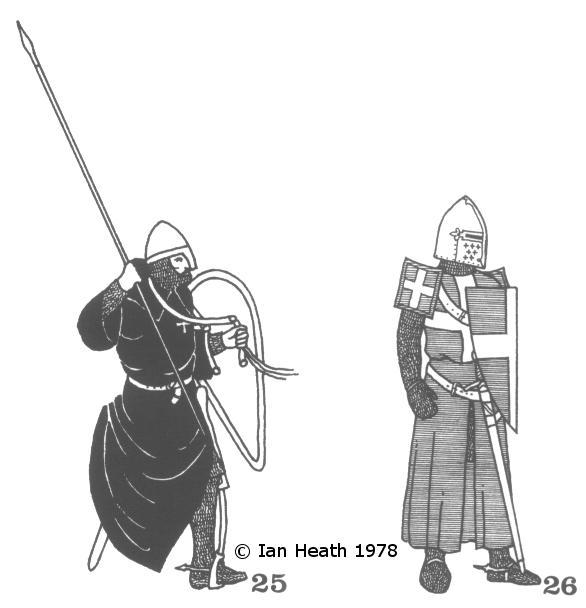KNIGHTS HOSPITALLER
An extract from Armies and Enemies of the Crusades 1096-1291
by Ian Heath
25 & 26. KNIGHTS HOSPITALLER
25 represents the probable appearance of a 12th century Hospitaller knight.
The voluminous, enveloping mantle, worn over their armour on active service, must have impeded the wearer considerably in battle, and in 1248 a Papal Bull finally authorised the adoption of a 'wide’, cross-embroidered black surcoat (as worn by 26) as ‘a remedy for the fact that when you are wearing the cappa clausa over your armour, which hampers both your hands and your arms, it makes it easier for your enemies to attack you and harder for you to defend yourselves’.
The surcoats of brother knights were changed to red in 1259, still with the Order’s white cross sewn upon them, the wearing of red surcoats being extended to brother sergeants from 1278.
Hospitaller Donats wore the uniform of brother knights.
As with the Templars, it is not known in what way early Hospitaler shields were decorated though probably most carried a cross.
The Hospitallers apparently only universally adopted a red shield with a white cross under the Grand Master Nicholas de Lorgne (1277-1285).
Unlike the Templars there is also a fair chance that at least some late-12th and 13th century Hospitallers, probably the senior officers, bore their own coats-of-arms on their shields (or so one must assume from 13th century Hospitaller legislation repeatedly - and apparently unsuccessfully - forbidding the decoration of arms and equipment).
By the middle to late-14th century Grand Masters often quartered their personal arms with the arms of the Order.
Next: 27. STANDARDS OF THE MILITARY ORDERS in Armies and Enemies of the Crusades 1096-1291 by Ian Heath

